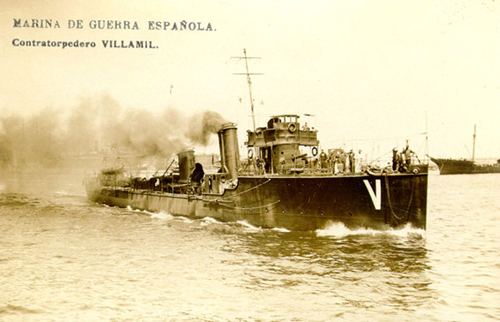Succeeded by Alsedo class Scrapped 3 | Preceded by Audaz class Completed 3 | |
 | ||
Displacement 530 long tons (540 t) normal | ||
The Bustamante class was a class of three destroyers of the Spanish Navy. They were built in Spain to a British design completing between 1914 and 1916. They served until 1930–32.
Contents
Design and construction
In 1908, the Spanish Cortes passed a Naval Law that reorganised Spain's naval dockyards to make them more efficient and allowing a modern navy to be built. The law also authorised a large shipbuilding construction programme, with two battleships, three destroyers, 24 torpedo boats and 4 gunboats to be completed by 1914. While the ships were to be built in Spain's newly refurbished shipyards, most of the ships would be of foreign design. The three destroyers were built by Sociedad Española de Construcción Naval (SECN), the consortium set up to refurbish and manage the Spanish shipyards, at Cartagena to a British design (either by Vickers or John Brown — both companies were part of the SECN consortium.).
The new destroyers were 64.7 metres (212 ft 3 in) long and displaced 530 long tons (540 t). They were powered by steam turbines, fed by Yarrow or Normand boilers and driving three propeller shafts. The machinery was rated at 6,250 shaft horsepower (4,660 kW) which gave a speed of 28 knots (52 km/h; 32 mph). Two funnels were fitted. Armament consisted of five Vickers 57-mm guns, two side-by-side on the ships' forecastle, one aft on the ships' centreline, and the remaining two guns on the ships' beam. Two sets of twin 450-mm (18 in) torpedo tubes were fitted.
The three destroyers, Bustamante, Villamil and Cadarso were laid down between 1911 and 1913. Bustamante and Villamil were launched in 1913 while Cadarso was launched in 1914. Bustamante was completed in 1914, with Villamil and Cadarso completing in 1916. Owing to the cessation of material support from Great Britain during the First World War Cadarso was fitted with 380 mm (15 in) torpedo tubes instead of the planned 450 mm tubes. By the time they entered service, the Bustamante class were outclassed by contemporary foreign destroyers, being poorly armed and slow.
Service
The ships carried out neutrality patrols around Spain's coasts during the First World War. They spent much of their time in a training squadron, and were disposed of in the early 1930s, with Cadarso being scrapped in 1930, Bustamante in 1931 and Villamil in 1932.
